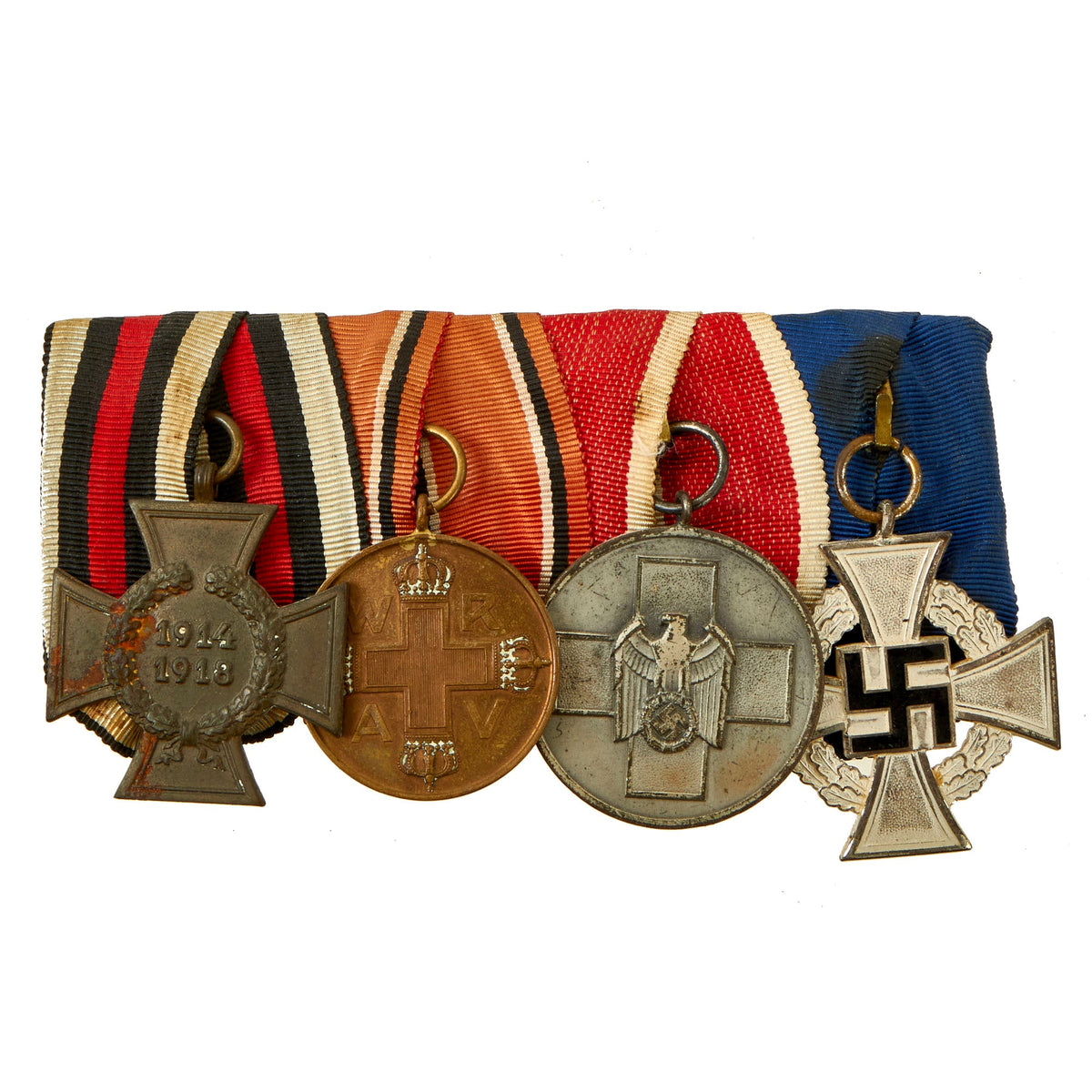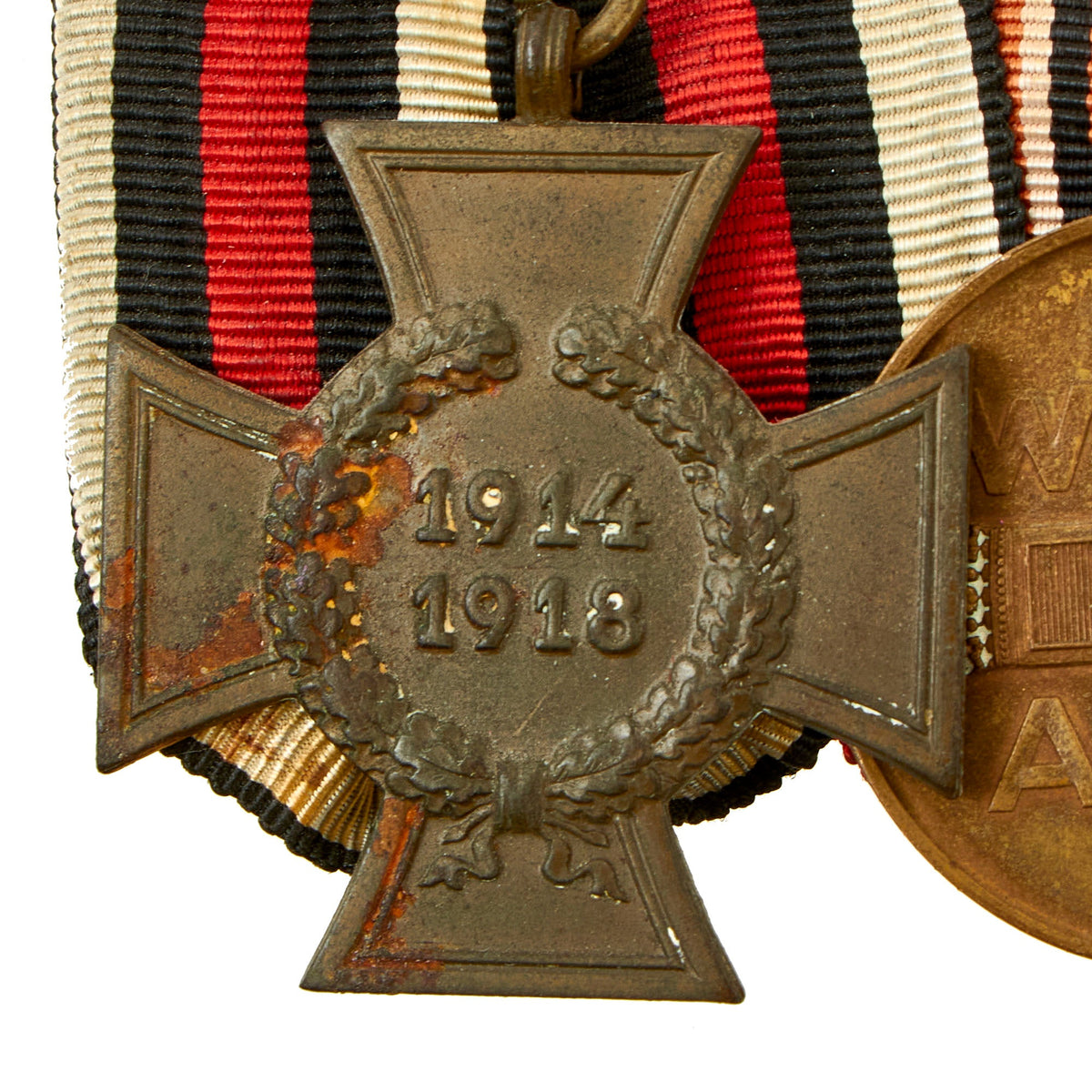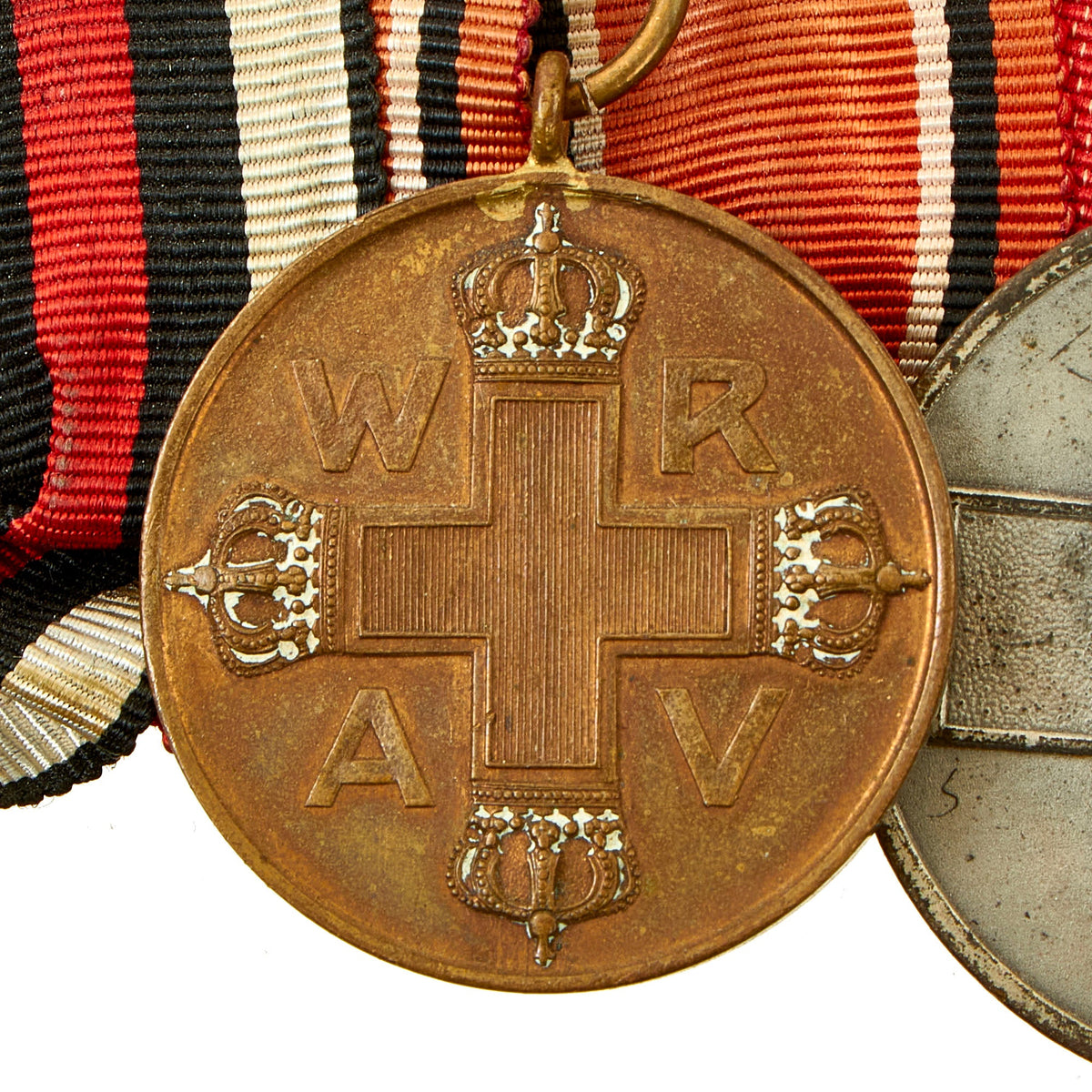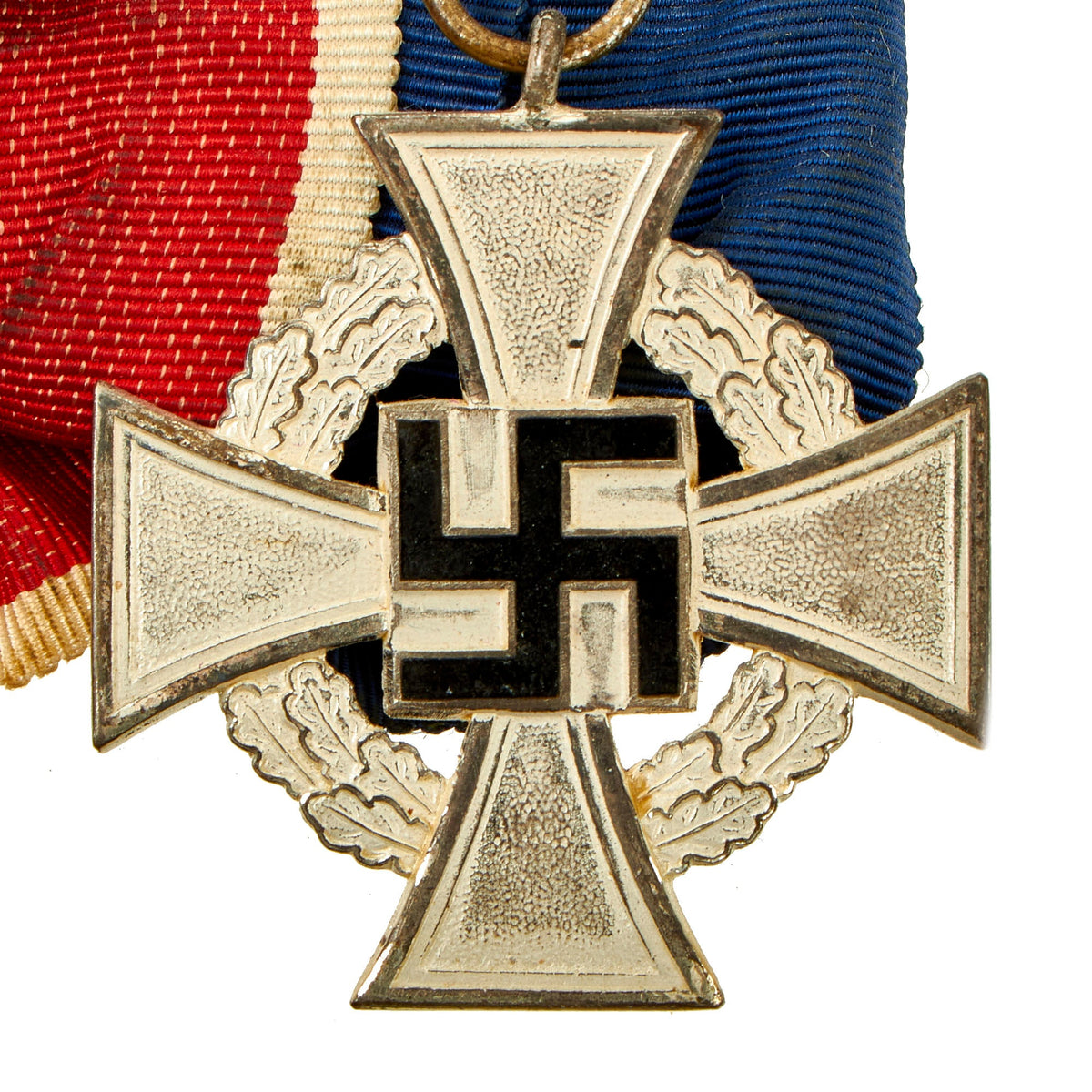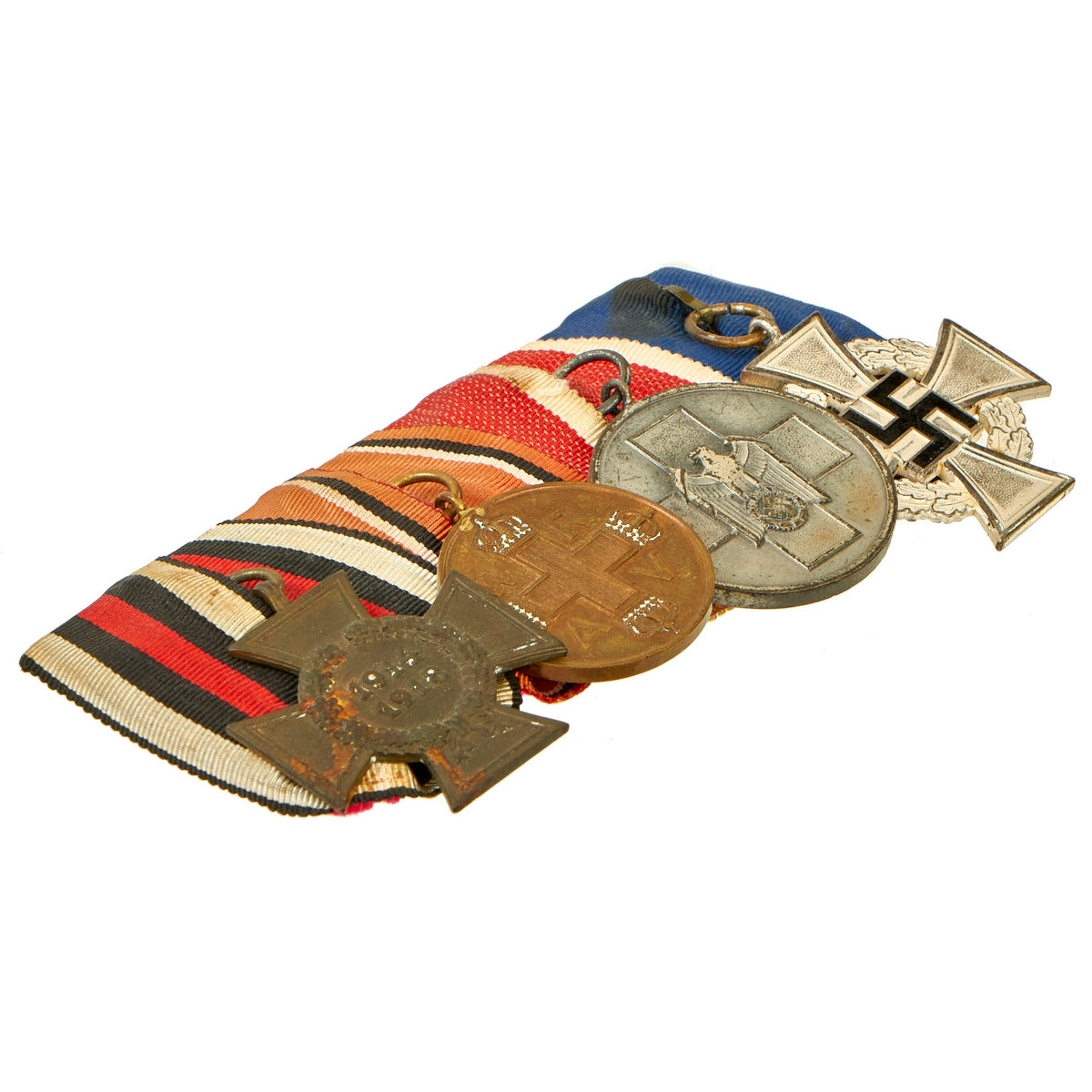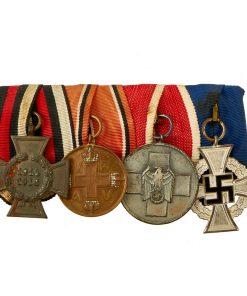Original German WWI & WWII Medal Bar with Hindenburg Cross, Red Cross Awards & 25 Year Service Decoration – 4 Awards Original Items
$ 250,00 $ 100,00
Original Item: One-of-a-kind. This is a very nice genuine medal bar, owned by a German soldier who fought during WWI, and then went into public service, where they continued to work into the WWII period probably in a field related to medical administration. The ribbons are a bit faded and stained, but overall the set is quite eye catching.
The set of 3 medals offered in good condition is mounted on a metal backing board with pin and lined in bright pink wool felt. It consists of the following medals:
– German WWI Honor Cross of the World War 1914/1918 (Hindenburg Cross) Medal with Swords (for combat)
– Imperial German WWI Prussian Red Cross Medal, Third Class
– German WWII DRK Red Cross Medal for Social Welfare
– German WWII Faithful Service Decoration 2nd Class Cross for 25 Years of Service
Below is an explanation of each medal in detail:
Hindenburg Cross with Crossed Swords (for combat):
The Honor Cross of the World War 1914/1918 (German: Das Ehrenkreuz des Weltkriegs 1914/1918), commonly, but incorrectly, known as the Hindenburg Cross was established by Field Marshal Paul von Hindenburg, President of the German Republic, by an order dated 13 July 1934, to commemorate the distinguished deeds of the German people during the First World War. This was Germany’s first official service medal for soldiers of Imperial Germany who had taken part in the war, and where they had since died it was also awarded to their surviving next-of-kin. Shortly after its issuance, the government of NSDAP Germany declared the award as the only official service decoration of the First World War and further forbid the continued wearing of German Free Corps awards on any military or paramilitary uniform of a state or NSDAP Party organization.
This example is marked on the back with CW, for Carl Wild of Hamburg.
The Prussian Red Cross Medal was a German medal set up on 1 October 1898 by Wilhelm II. It had three classes and could be awarded to all those who carried out great service to the sick in peace or wartime, or for special achievement in the service of the German Red Cross. Though service to the sick during times of war had been recognized with prior awards of the Order of the Crown and General Honor Decorations with the Red Geneva Cross, Empress Augusta Victoria the royal patroness of the organization wanted an award to recognize work in peacetime as well.
The Red Cross Medal was awarded in three classes, the Second and Third classes being worn as circular medals suspended from a red ribbon with white and black stripes. The First Class was a red enameled Geneva Cross with gilded Prussian Royal Crowns at the ends of the arms. This award was worn as a steckreuz on the breast, like the Iron Cross. Recipients could be promoted to the next class of the medal with five years time in service, with the first level anyone could be initially appointed to being the Second Class.
German WWII DRK Red Cross Medal for Social Welfare
The Social Welfare Decoration (German: Ehrenzeichen für deutsche Volkspflege) was a German Civil Award created by Adolf AH on 1 May 1939 for services in the social sector. The decoration was issued in three classes and was awarded for a wide variety of service, in the social sector, to the German state. Qualifying service would have been with Winterhilfswerk, National Socialist People’s Welfare, medical and rescue work, or care of foreign and ethnic Germans. As a replacement for the German Red Cross Decoration, it was conferred in four classes consisting of a white-enameled gold Balkenkreuz with Reich eagle and swas. A “Medal for Social Welfare” was also issued for lesser degrees of service, not warranting the higher presentation of a class award.
The main requirement for the award was that the service rendered should be to the benefit of the civil population. Reinhard Heydrich was awarded the decoration for his running of the Gestapo in the 1930s and for providing “security” to the German people. The infamous Doctor Josef Mengele was also awarded the decoration in 1941, for providing medical services to wounded soldiers and civilians alike on the battlefields of the Eastern Front.
Faithful Service Decoration Second Class Cross for 25 Years of Service – A fullsize frosted silver with an oak leaf wreath and black enameled swas on original ribbon.
The Civil Service Faithful Service Medal (Treudienst-Ehrenzeichen für Beamte Angestellte und Arbeiter im öffentlichen Dienst) was a NSDAP Germany medal of honor that was founded on 30 January 1938, in two grades, to reward civilians and military in the employ of the German public services for long and faithful service.
All officials, employees, and laborers at any level of the public service (local, regional or national) who complete 25 or 40 years service were eligible. The second class award was for 25 years of service was a silver cross, with a silver wreath and a black enameled swas in the center of the cross. The first class award was for 40 years of service was a gold cross, with a gold wreath and a black enameled swas in the center of the cross.
The reverse of both classes was stamped with Für treue Dienste (For faithful Services). in German black letter typeface. The ribbon for the medal is cornflower blue.
Fast Shipping with Professional Packaging
Thanks to our longstanding association with UPS FedEx DHL, and other major international carriers, we are able to provide a range of shipping options. Our warehouse staff is expertly trained and will wrap your products according to our exact and precise specifications. Prior to shipping, your goods will be thoroughly examined and securely secured. We ship to thousands clients each day across multiple countries. This shows how we're dedicated to be the largest retailer on the internet. Warehouses and distribution centres can be located throughout Europe as well as the USA.
Note: Orders with more than one item will be assigned a processing date depending on the item.
Before shipping before shipping, we'll conduct a thorough inspection of the items you have ordered. Today, the majority of orders will be delivered within 48 hours. The delivery time will be between 3-7 days.
Returns
The stock is dynamic and we cannot completely manage it because multiple stakeholders are involved, including our factory and warehouse. So the actual stock may alter at any time. It's possible that you may not receive your order once the order has been made.
Our policy is valid for a period of 30 days. If you don't receive the product within 30 days, we are not able to issue a refund or an exchange.
You can only return an item if it is unused and in the same state as the day you received it. You must have the item in its original packaging.
Related products
Uncategorized
Uncategorized
Uncategorized
Uncategorized
Uncategorized
Armoured Fighting Vehicles of the World: AFVs of World War One (Hardcover Book) New Made Items
Uncategorized
Band of Brothers ORIGINAL GERMAN WWII Le. F.H. 18 10.5cm ARTILLERY PIECE Original Items
Uncategorized
Uncategorized
Uncategorized
Armored Burgonet Helmet & Polearm from Scottish Castle Leith Hall Circa 1700 Original Items
Uncategorized
Australian WWII Owen MK1 Machine Carbine SMG Custom Fabricated Replica with Sling Original Items
Uncategorized
Uncategorized
Uncategorized
Angolan Rebel 1970s era 60mm Inert Display Mortar from Angolan Civil War Original Items
Uncategorized
Uncategorized
Uncategorized
Uncategorized
